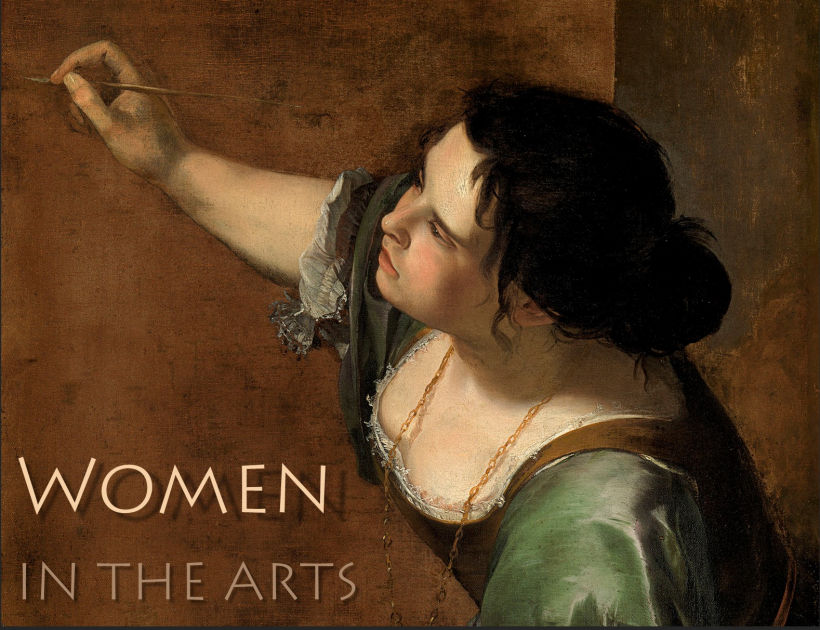4. At Her Majesty's Command.
Fourteen powerful women: Empresses, Queens, Archduchesses, consorts and mistresses of Kings; all frequently
appear on lists of great patrons of the arts, but the nature of their patronage differs. All had artists
paint their portraits. Most had buildings built to their requirements. A few worked directly with other
kinds of artist to create new work, though more have been the figurehead to whom such works were dedicated.
Several built up impressive collections of older art. While all of them played a role in history and led
fascinating personal lives into the bargain, I'm afraid I have to go light on biography if I am to discuss
their motives for patronage—and, above all, to sample some of the great works by both women and men created
in their name.
The chart below (which will also be shown in class) lists the fourteen women in question,
the centuries in which they lived, and the headings under which we will discuss them. While a woman's influence,
even at court, is often subtle and ambiguous, I have chosen two topics as more directly reflecting her wishes:
the buildings she had constructed, and the portraits she had painted. In the second hour, we shall look at five
women in a little more detail: two more British queens (Elizabeth I and Queen Anne), two mistresses of French
kings (Mmes de Montespan and Pompadour), and "The Great Collector," Catherine the Great of Russia. rb.
The script, videos, and images will be posted immediately after class. There is no text handout.
Here are brief bios of the artists, composers, and writers considered in the class, listed in order of birth.
All the specific biographies of women featured in the course are collected in the
BIOS link on the syllabus page.
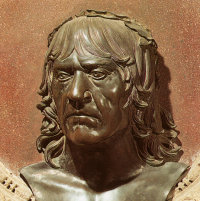 |
Andrea Mantegna, 1431–1506. Italian painter.
Mantegna's work is characterised by formidable skills in drawing and color, passionate interest in classical antiquity, formal invention, and frequent sparks of wit. He spent the last 45 years of his life as court painter to the ruling Gonzaga family in Mantua, and all of these qualities show up in his painted decoration of the Camera degli sposi in the ducal palace.
|
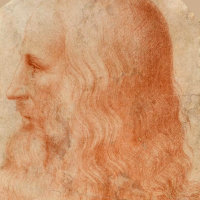 |
Leonardo da Vinci, 1452–1519. Italian painter and polymath.
With Michelangelo and Raphael, one of the triumvirate of artistic geniuses that crown the High Renaissance. He trained in Florence with the painter Andrea Verrocchio before moving to the court of Ludovico Sforza in Milan. He spent the last years of his life at the court of François I in France. The naturalism and luminosity of his painting, and his effects of sfumato (or modeling as if by smoke), were widely influential. It is his notebooks, however, that are the best testament to the range of his genius, containing remarkable observations of the natural world, and mechanical inventions centuries before their time.
|
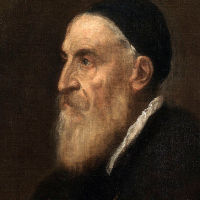 |
Tiziano Vecellio (Titian), 1485–1576. Venetian painter.
Arguably the greatest Venetian painter of the High Renaissance, he produced works in just about every genre over an exceptionally long career. Probably his greatest influence was in his handling of paint and use of color, which became a starting point for Rubens and others in the next century.
|
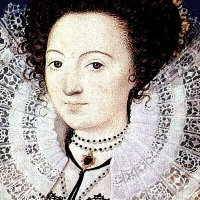 |
Aemilia Lanyer, 1569–1645. English poet.
"Aemilia Lanyer was the first woman writing in English to produce a substantial volume of poetry designed to be printed and to attract patronage. […] The volume is also arguably the first genuinely feminist publication in England: all of its dedicatees are women, the poem on the Passion specifically argues the virtues of women as opposed to the vices of men, and Lanyer's own authorial voice is assured and unapologetic." [Poetry Foundation]
|
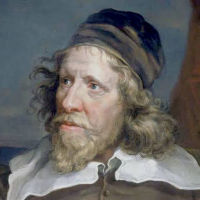 |
Inigo Jones, 1573–1652. English architect.
In buildings such as the Queen's House in Greenwich and the Banqueting House, Whitehall, Jones showed himself the first English master of classical architecture based on the precpts of Vitruvius and the example of Palladio.
|
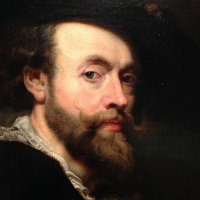 |
Peter Paul Rubens, 1577–1640. Flemish painter and diplomat.
One of the giants of baroque art, Rubens developed the style of Titian into a powerful rhetoric applied equally to sacred and profane subjects, and exerted enormous influence in Spain, England, and France as well as in his native Flanders, continued in the work of his many pupils. His position at so many courts also made him invaluable as a diplomat.
|
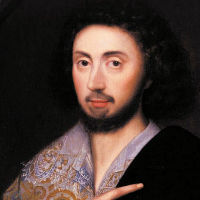 |
Robert Johnson, 1583–1633. English composer.
A lutenist and composer of the late Tudor and early Jacobean eras, Johnson wrote music for many masques and several of Shakpespeare's later plays. [The image, though in period, is not Johnson's portrait.]
|
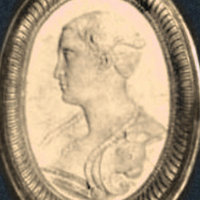 |
Francesca Caccini, 1587–1640. Italian composer.
Francesca was the daughter of Giulio Caccini, a member of the Florentine Camerata, and one of the earliest composers of opera; her own Liberazione di Ruggiero (1625) is regarded as the first opera composed by a woman. Her career at the Medici court was interrupted by two marriages, the second to a nobleman; both husbands and her only child died after a few years.
|
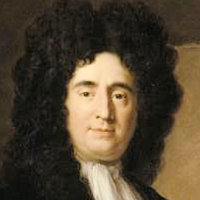 |
François de Troy, 1645–1730. French painter.
Troy, who became director of the Académie Royale, worked in the French court for almost half a century, including the production of tapestry designs and portraits for Mme. de Montespan and her family.
|
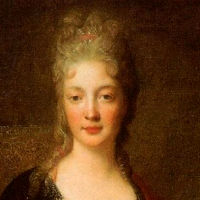 |
Élisabeth-Claude Jacquet de la Guerre, 1665–1729. French composer.
The daughter of an instrument builder, Jacquet was a child prodigy who at the age of ten was called "the marvel of our century" by a Paris paper. Louis XIV took her to Versailles and put her into the care of Mme. de Montespan, under whose protection she produced works in most genres including an opera, Céphale et Procris (1694).
|
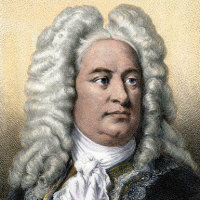 |
George Frideric Handel, 1685–1759. German-born English composer.
Gradually over the last half-century, Handel's 42 operas and numerous dramatic oratorios have been recognized as placing him on the level of Mozart and Verdi as an opera composer. The delay in appreciation is partly due to the fact that his preferred form, opera seria, is based almost entirely on recitative and solo arias. Born in Germany and trained in Italy, he dominated the English musical scene in the first half of the 18th century.
|
 |
Jean-Marc Nattier, 1685–1766. French painter.
Nattier aspired to being a history painter, but he is best known for his portraits of members of Louis XV's court, many of them in mythological attire.
|
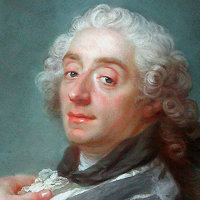 |
François Boucher, 1703–70. French painter.
His many works, which virtually define the French rococo style, include several elegantly erotic treatments of mythological subjects, such as his Jupiter and Callisto, but also genre scenes, erotica, and even landscapes.
|
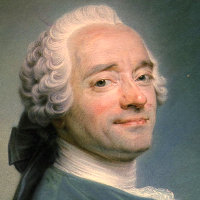 |
Quentin de la Tour, 1704–88. French painter.
A portraitist working mainly in pastels, La Tour worked for the French Court from about 1745 to 1760, and was given an apartment at the Louvre. Remaining single, he devoted much of his considerable earnings to philanthropy, in support of aging or disabled artists.
|
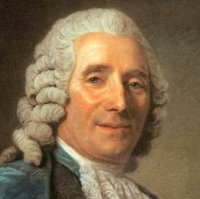 |
Jean-Baptiste Pigalle, 1714–85. French sculptor.
Pigalle was noted, especially in his young years, for sculptures that broke free from convention, such as Mercury Putting on his Sandals and a nude statue of Voltaire (both in the Louvre).
|
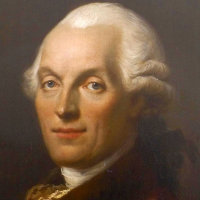 |
Richard Mique, 1728–94. French architect.
Mique was a relatively conventional architect in the neo-classical style, but he is best remembered for the rustic hameau he created for Marie Antoinette in the grounds of Versailles. Unfortunately his devotion to the Queen led to his execution in the last days of the Reign of Terror.
|
 |
Charles Cameron, 1745–1812. Scottish architect.
After a checkered career in London, Cameron went to Russia in 1779, where he was engaged by Catherine the Great to supervise the archicture, landscape, and interior design of her buildings at Tsarsoye Selo. Though an eccentric personality, he left some of the most exquisite examples of neoclassical design.
|
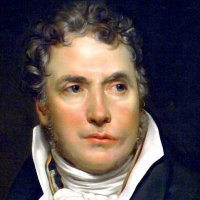 |
Jacques-Louis David, 1748–1825. French painter.
The leading Neoclassical artist of his day, David replaced rococo frivolities with stern history paintings with strong moral content. He was a dedicated supporter of the Revolution and politically active as a Deputy. He was imprisoned briefly after the fall of Robespierre, but resurfaced as principal painter to Napoleon. Through his many pupils, he influenced French salon style for a generation.
|
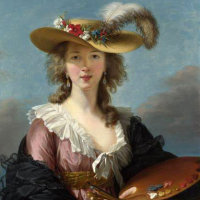 |
Élisabeth Vigée Le Brun, 1755–1842. French painter.
Specializing in portraiture, Vigée-Lebrun had charm and wit to match her talent, which won her many influential patrons, most notably Queen Marie Antoinette. She fled France at the Revolution and lived in London, Italy, Vienna, and St Petersburg, where she was part of the court of Catherine the Great. Her memoirs are a vital testament of her times and her own remarkable strengths as a woman.
|
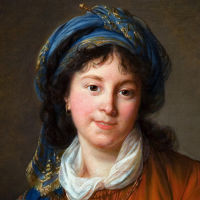 |
Princess Natalia Ivanovna Kourakina, 1766–1831. Russian composer.
Kourakina (née Golovina) became the most prolific Russian composer in the era of Catherine the Great. A singer and harpist herself, she wrote mainly songs for salon performance, but these were published and distributed widely. After her husband quarreled with Tsar Paul I in 1815, she moved to Paris, where she hosted a salon of her own.
|
 |
Franz Xaver Winterhalter, 1805–73. German painter.
Although of peasant stock, he became drawing master to the Margravine of Baden in 1828. Her father supported his further study, and he eventually became the most sought-after court painter in Europe in the mid-19th century.
|
 |
Heinrich von Angeli, 1840–1925. Austrian painter.
Wikipedia notes that "the success of Angeli at painting society portraits was partly due to his skill in depicting uniforms, pearls, and other jewels." Yet Queen Victoria praised his late portraits of her for their "honesty, total want of flattery, and appreciation of character.”
|
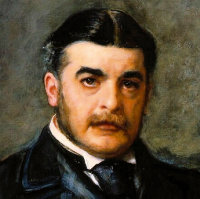 |
Sir Arthur Sullivan, 1842–1900. English composer.
Sullivan essentially had two careers: as a classical composer of orchestra music and oratorios on suitably uplifting subjects, and as the musical partner to W. S. Gilbert on the highly successful series of Savoy Operas from HMS Pinafore (1878) to The Gondoliers (1889) and beyond. History only remembers him in the latter role.
|
 |
Katharine A. Carl, 1865–1938. American painter.
As a portraitist, Carl "made paintings of notable and royal people in the United States, Europe and Asia. She spent nine months in China in 1903 painting a portrait of the Empress Dowager Cixi for the St. Louis Exposition, and wrote a book about the experience on her return." [Wikipedia]
|

